We shall call them mini meetings
Note: this article was recently updated to reflect the delayed delivery date of breakout rooms. Availability was moved from October 2020 to November 2020 and again to December 2020. Rollout will begin early December and finish by mid-December. Edited 11 November.
One of the most anticipated features in Microsoft Teams is finally here: breakout rooms. Breakout rooms are a way to separate the participants in a meeting into mini meetings, either randomly or by organizing them yourself. They’re especially useful in online classes, corporate events, board meetings with committee breakouts, and organization retreats with brainstorming breakouts. For a video overview of this post (which might be more helpful because it includes a lot of demos), click play below.
Breakout rooms are one of the highest-voted feature requests for Microsoft Teams as seen in the below UserVoice request.

Incidentally, if you’re not familiar with UserVoice and you want to make feature requests known, make sure to vote for the ones you think are important at microsoftteams.uservoice.com. Microsoft pays close attention to this site when determining which features to prioritize; I can attest from personal experience working with them, actually.
Breakout rooms turn out to be reasonably simple to set up and manage, so let’s cover some of the bigger features built into them, and especially what they can’t do yet. Fair warning that most of what you see is in preview at the time of posting. Something I say or show here may not look or act the same when you’re watching, but likely the big picture concept remains.So if you’re not seeing the right button in the right place, look around a little. You’ll probably find it.
Another big-picture comment: breakout rooms are currently in private preview. Microsoft recently updated the roadmap item to indicate that breakout rooms will be available in November, pushed from the original delivery timeframe of October.
And, while I was under the impression that if the organizer of the meeting has breakout rooms, even external people in the meeting can take part in them, after testing, I’ve run into an issue where external participants cannot be assigned to breakout rooms. I’m told it’s supposed to support external people once it’s available to everyone; for the time being your mileage may vary.
Create your breakout rooms
To create your rooms, for now you’ll have to be using theTeams desktop app—not mobile or web app—and you have to be the meeting organizer. Only the meeting organizer can create breakout rooms. That means literally only one person in the meeting is able to do this and must be present throughout the time you want to use breakout rooms for them to be used in a meeting.
Click the breakout rooms button in the meeting toolbar. Note that the breakout rooms icon might be either of the two shown below. The one on the right is the one I think they’re going with as a final version. Also, I’ve even seen examples where it’s housed in the ellipses menu. Microsoft is still finalizing how it’ll look and where it’ll live apparently.
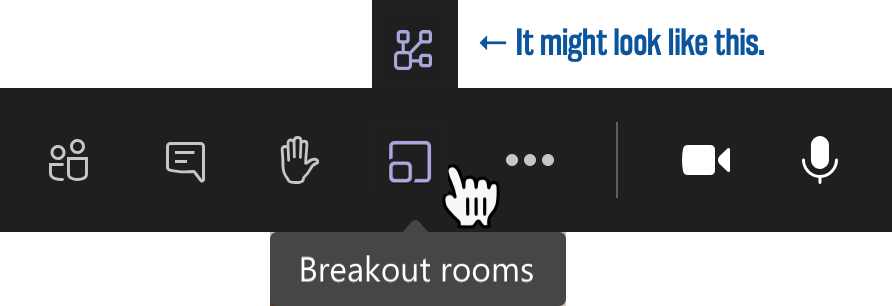
Choose how many rooms you’d like—up to 50—and decide whether you’d like to have attendees randomly and evenly distributed among the breakout rooms or if you’d like to organize the rooms manually.
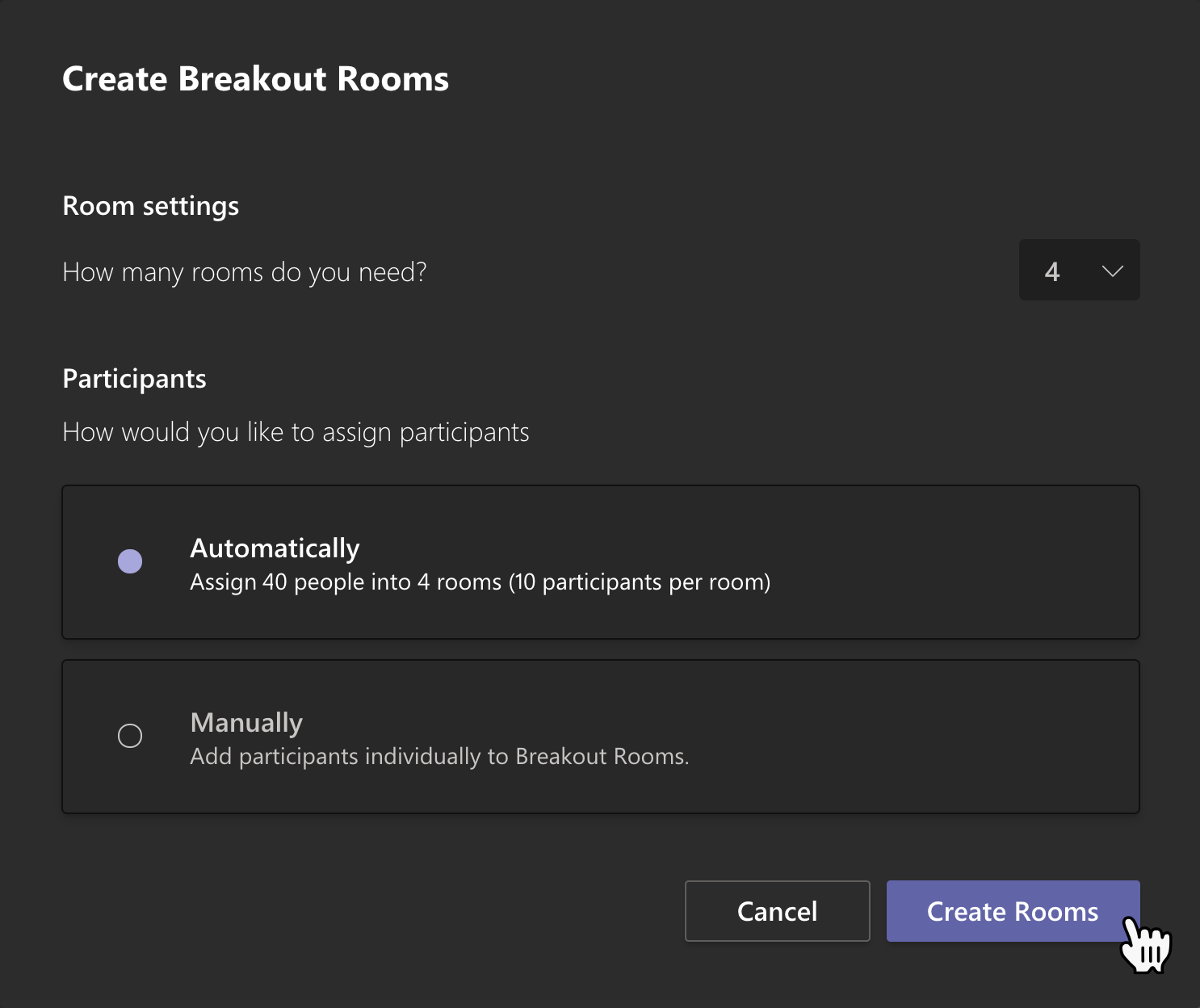
Once created, the rooms should all say Closed next to them; they’re not available to join yet and won’t be until you open them.

Right now, breakout rooms can only be created in standard scheduled meetings and can’t use them in channel meetings—though I think that’s only a limitation during the private preview. You can only organize participants into the breakout rooms once the meeting has started. Also for now, only the meeting organizer can create and open breakout rooms in a meeting. Presenters and attendees are unable to do that. That means if you organize the meeting you must be present for the meeting to make use of the breakout rooms.
Rename your breakout rooms
By default, your breakout rooms will be named Room 1, Room2, etc. You can rename these by clicking the ellipses menu to the right of the room name to rename it. Renaming isn’t critical, but it can add an element of fun if not general organization to your process. For example, if you’re holding a model UN event, it wouldn’t make much sense for Denmark and Bolivia and Australia to meet in Rooms 1, 2, and 3, right? Hell, you can use emoji to label the rooms if you want. 🇩🇰 🇧🇴 🇦🇺

Add a breakout room
After you’ve created your breakout rooms, you can add more, one at a time if you’d like. Click Add room in the breakout room pane.
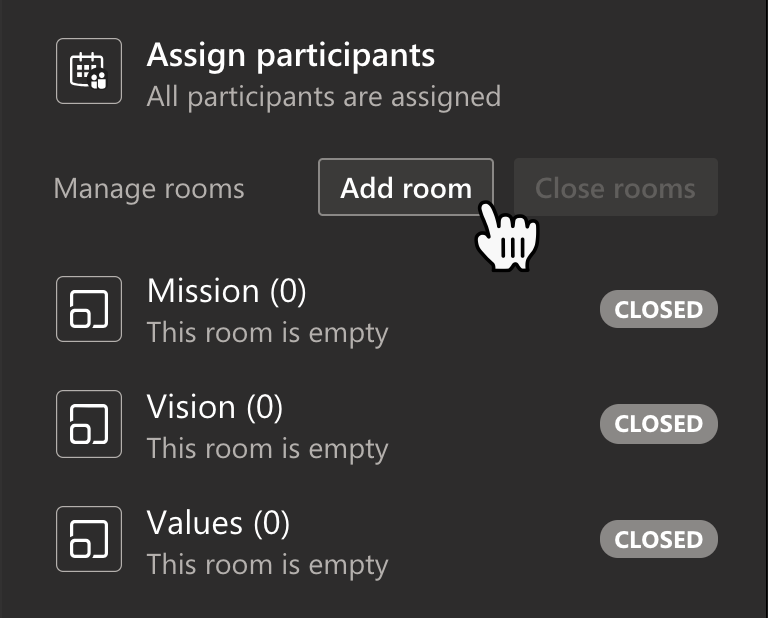
Delete a breakout room
After you’ve created your breakout rooms, you can delete them one at a time if necessary. Click the ellipses menu next to each room to delete them. If participants have already been split up, the participants will be dropped in the main room, waiting for reassignment.
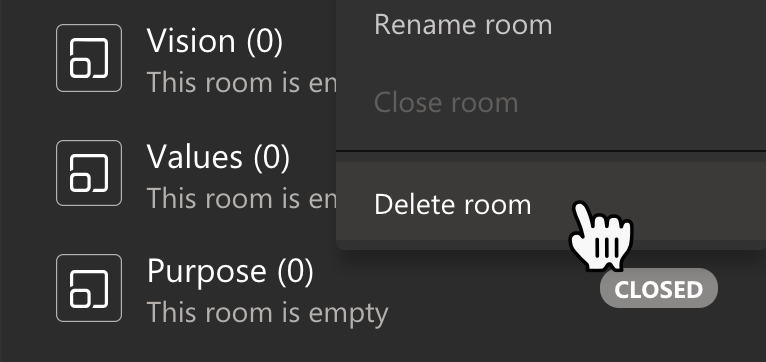
Set participants to be sent to rooms automatically (or not)
When you open your breakout rooms, there are two ways participants join: they are either given the choice to join or they are forcefully sent to their breakout room. For corporate environments, being able to choose might make sense, but for classroom situations, you almost certainly want to make sure your students are automatically sent to the breakout room.
To toggle this option, click the ellipses in the breakout room pane, click Settings, and check or uncheck Automatically move people into opened rooms as appropriate to your situation.

If you’ve checked the box, attendees will see a countdown until they’re automatically joined into their breakout room. If you’ve unchecked the box, attendees will be presented with a pop-up asking if they want to join. You can see whether they join from the breakout room pane.
Open your breakout rooms
Once your breakout rooms are created and you’re ready to split up your meeting into your rooms, click the Start rooms button to start all the rooms at once. Or you can open them one-by-one by clicking the room’s ellipses and selecting Open room to set each up individually. This disperses your participants into their assigned room.
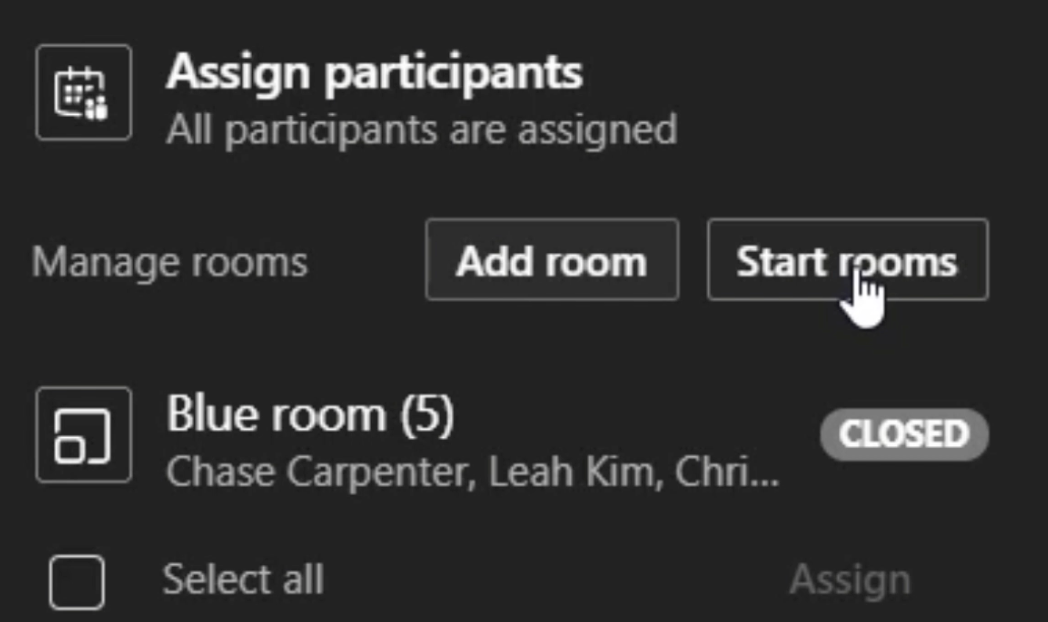
Once attendees join their breakout room, they have all the powers of a presenter in their breakout room. Notably, that means they can share their screen.
Assign or switch participants between breakout rooms
In the event you need to swap people out between rooms, you have the power to do that. To move participants between rooms, expand the room name in the breakout room pane, click the checkbox next to name and click the Assign button. Select the room you want to move them to. This is also how you assign attendees if you chose to set up your rooms manually.
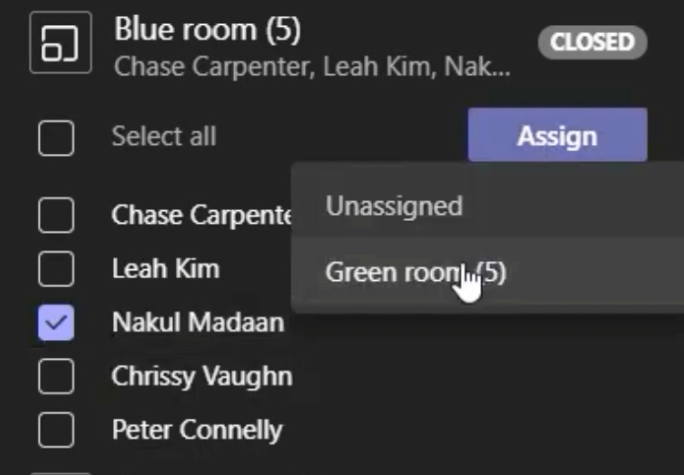
Send an announcement to all breakout rooms
The meeting organizer can broadcast an announcement message via meeting chat to all breakout rooms so everyone in all rooms are informed of updates, changes, or news during their breakout sessions.
To create an announcement, click the ellipses in the BreakoutRooms pane and select Make an announcement. In the pop-up box, write your announcement then press Send.
This message is an important-labeled message in the breakout room chat, so anyone in the breakout room can see it and respond to it, including @mentioning the organizer to get their attention if required.

That said, the organizer has access to the chat for each breakout room via the chat icon in the Teams app bar. They show up like meetings. So you don’t necessarily need to join a meeting to take part in conversation. And if you want to send room-specific “announcements”, just use the room chat for it.
Join a breakout room as the organizer
The organizer cannot be in all breakout rooms at once; however, they can jump between breakout rooms as necessary. To enter a breakout room, click the room’s ellipses and selecting Join room.
There is no warning that you’re entering the room. If privacy or a general ‘right to know’ attitude exists in your organization, it makes sense to announce that you’ve joined so everyone knows that you’re there.Maybe a chat message warning your impending arrival makes sense as well.
Record breakout rooms
The meeting organizer can begin recording by jumping between each room. To record the breakout room, you need to be in it. In the meeting toolbar, click the ellipses then click Record. There is no way currently to automatically set all breakout rooms to start recording automatically upon opening.
At present, I’m seeing conflicting reports on whether an attendee can record the breakout room. Upon testing, I as an attendee could not. Though Microsoft documentation says breakout room attendees should have presenter status, which includes recording. Worst-case scenario is the organizer needs to start recording when all breakout rooms open.
Sharing and accessing files
While breakout rooms are open, attendees can upload files to the room chat for sharing and collaborating. To share a file in a breakout room, open the breakout room chat from the Chat icon the app bar in the main Teams window (not the meeting window nor the breakout window). Find the chat for the breakout room. Below the chat text box, click the paperclip icon to upload a new file or share an existing file from OneDrive. Press send once you're ready. Everyone else in the breakout room (including the meeting organizer) will be able to access the file and edit it live at the same time as you.
If you're looking for the files later on, they'll centrally located in a tab above the chat called Files. Again, click the Chat icon in app bar in the main Teams window, find the chat for the breakout room, point your mouse to the top of the chat space, and click the Files tab. Any files shared by anyone in the breakout room will be available there during and after the breakout room (or meeting).
What attendees can do in a breakout room
Attendees can join from Teams on desktop, mobile, or the web. At least, once breakout rooms is generally available, so likely near the end of October 2020. If it does work for you and you continue to see the word Preview in the breakout rooms pane, there’s no guarantee it’ll work tomorrow, so don’t make this something you depend on. Always have a backup plan until that Preview label is gone.
While in a breakout room, meeting attendees are supposed to be given the presenter meeting role, meaning they’re able to share their video, audio, screen, a whiteboard, and files and they can record the breakout room; note that the attendee role does not have most of these rights in the main meeting. Keep in mind what I said just before about recording. Your mileage may vary.
What attendees cannot do in a breakout room
- Attendees cannot add participants.
- Attendees will not see suggestions of people who should join (organizers may).
- Attendees cannot get meeting details or dial out(akin to not being able to add participants).
- Attendees cannot rejoin the original meeting themselves.
Close your breakout rooms
Once you as the organizer decide it's time to end the breakout rooms, you can close them, pulling everyone back into the main meeting. To close your breakout rooms, click the Close rooms button to close all the rooms at once. Or you can close them one-by-one by clicking the room’s ellipses and selecting Close room to close out each individually. At this time, breakout room participants cannot return to the main meeting room on their own nor can they close their own breakout room.

After your breakout rooms
Once you close your breakout rooms, you can actually re-open them if you want. They will have the same artifacts—shared files, whiteboards, things like that—as before so the attendees can work on existing content. Or you can delete the existing breakout rooms and create new ones for a fresh experience.
Like regular meetings, you can download an attendance list and transcript. The recording will become available afterwards via MicrosoftStream as well. Only breakout room attendees and the organizer will have access to these because they’re in the breakout room-specific meeting chat, at least until the new meeting recap feature rolls out. Which, if you hadn’t heard about that, is really cool. Check out my Ignite 2020 Recap for more really cool Teams features coming soon.
Using breakout rooms with guests and external users
Breakout rooms can be used by any logged-in or anonymous participant using the Teams desktop or mobile app, at least once you’re out of preview mode. Participants using a dial-in number or certain meeting-room devices—don’t ask me which ones—cannot join breakout rooms yet. In those situations, use the main meeting room as a breakout room for those people.
What’s coming
This post covers version 1 of breakout rooms, which is rolling out in September and October 2020. After that, Microsoft is planning further features, none of which have expected due dates I’m aware of as of yet.
Most importantly I would think, organizers will be able to share the ability to create and manage breakout rooms with other presenters.
Organizers be able to create breakout rooms and organize participants ahead of a meeting in a new breakout rooms tab in the new central meeting experience. While the organizer will see all breakout rooms, an attendee will only see the breakout room they’re assigned to.
Organizers will be able to use Teams tags—thoseTeam-specific people groupings you can use to organize people independent of existing Team or channel membership—to assign them to breakout rooms, which could save a lot of time. As an example, if you have a classroom for PhysicsLab and channels for each lab topic, tags for Lab group 1, Lab group 2, etc.let you organize people in a way your Team and channel setup couldn’t. Those tags are what you’ll be able to use soon enough.
Presenters will be able to share files, whiteboards, and other artifacts from the breakout rooms in the main meeting.
And lastly, a few other items mentioned include the ability to create breakout room templates so you don’t have to recreate room setups each time you schedule a meeting, and breakout rooms in channel meetings and meet now meetings are forthcoming.
Wrap up
So that’s a brief overview of what you can do with with breakout rooms in Microsoft Teams meetings. One important takeaway tip for you:test this thing out before you use it. Grab a friend or colleague—or a few—and try it out before you use it live during a meeting or class. You don’t need a ton of people to test it. It’s like any other thing in life: without trying it first, you may be surprised how it does or doesn’t work when you actually need it.
So hopefully you found this useful. A friendly reminder—for like the tenth time—that the breakout rooms feature is still in preview as of the time of publishing! Things might be a bit different in your system. In fact, if you notice differences, I’d love if you could comment below with what you see so others can keep their eyes peeled and be prepared for impacts on them.
Thanks for reading and happy testing, playing, and making the most of breakout rooms in Teams!





Obviously you have an opinion, so share it!